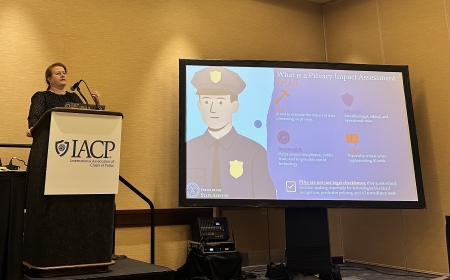This year is packed with must-attend events for Law Enforcement and Government professionals looking to stay ahead of the latest technology trends.
Carahsoft’s Law Enforcement Technology Team gathered a list of the best events for law enforcement and Government officials to attend. These events offer valuable insights, hands-on learning and opportunities to explore cutting-edge solutions from our trusted vendor partners.
Here are the top events to watch for in 2025 and beyond.
We look forward to connecting with you.
National Sheriff’s Association Annual Conference
June 23-25 | Fort Lauderdale, FL | In-Person Event
The National Sheriff’s Association (NSA) Annual Conference is the largest of its kind. It features a tradeshow displaying products and equipment relevant to every facet of police work, jails, prisoner transport and courtroom security. This four-day event includes highly curated seminars and educational content covering cutting-edge subjects for Law Enforcement at all levels.
Look out for NSA’s seminar schedules, estimated to have 70 different sessions covering 11 different tracks.
Carahsoft will have a booth at this event, where several of our vendor partners—Cellebrite, Check Point and Achievelt— will be demoing their solutions and sharing their educational content. We will also be hosting a networking reception from 6:30-8:30 pm with several of our vendor partners, welcoming conference attendees for food, drinks, networking, and more!
Florida Sheriffs Association Summer Conference
July 27-30 | ChampionsGate, FL | In-Person Event
The Sheriffs Summer Conference, usually held in central or south Florida, is the largest event of the year, providing participants with continuing education opportunities, networking, sharing of best practices, association news, award recognition and important updates in the field of Law Enforcement.
Attendees should look for sessions that cover legal affairs and Law Enforcement technology.
Carahsoft will be exhibiting at this event, and we’re excited to welcome you to join us to learn about our leading Law Enforcement technology vendor partners.
National Homeland Security Conference
August 25-28 | Washington, D.C | In-Person Event
The National Homeland Security Conference brings together professionals in Homeland Security, Law Enforcement and Fire and Emergency Management. Including officials in Federal agencies, nonprofit agencies, business owners, universities and decision makers, attendees will learn about emerging trends in homeland security and see the new equipment and technology available to support their mission.
Carahsoft maintains strategic partnerships with Mark43, Cellebrite, Magnet Forensics and AWS. These collaborations enable Carahsoft to offer a comprehensive range of law enforcement technology and services to the public sector. By leveraging the strengths of these industry giants, Carahsoft ensures that law enforcement agencies have access to cutting-edge technology for enhanced security solutions. For more information, visit Law Enforcement Technology Providers | Carahsoft.
Major County Sheriffs of America 2025 Annual Conference
September 22-24 | Dallas, TX | In-person Event
As a professional association representing the largest Sheriff’s offices in the United States, the MCSA is dedicated to promoting a greater understanding of Law Enforcement strategies. Working alongside corporate partners and Public Sector agencies, the MCSA aims to advance legislation to enhance the safety of the community.
As a proud Sergeant-level partner, Carahsoft will be attending this conference to learn, collaborate and network with the Law Enforcement community.

IACP Annual Conference
October 18-21 | Denver, CO | In-Person Event
The IACP Annual Conference is a leading event for Law Enforcement executives, featuring in-depth educational sessions on critical topics such as leadership, policy development and community relations. It also includes an extensive exhibit hall showcasing advanced technologies and solutions, drawing thousands of police chiefs, commanders and public safety professionals from around the world for training, networking and collaboration on modern policing challenges.
Carahsoft is thrilled to be exhibiting at IACP Annual Conference. Be sure to stop by our booth to see live demos from our vendor partners as they showcase how their technology is helping Law Enforcement today.
2026 Law Enforcement Innovation Summit
This annual event, hosted by Carahsoft, unites relevant vendors, partners and Law Enforcement customers for a day of panels, speaking sessions and networking. Attendees learn about an array of Law Enforcement and cybersecurity related topics, including legislative updates concerning grant funding in the field, how to maximize technology in a privacy-conscious society, the modernization of Law Enforcement technology surrounding forensic investigations and the cloud, tips for collaboration and information sharing among the industry and the current cybercrime landscape.
In 2026, the Law Enforcement Innovation Summit will convene professionals from across the law enforcement community for a day of insightful panels, expert-led sessions and valuable networking opportunities. A central focus will be the evolving role of AI in law enforcement—balancing innovation with caution as agencies address the risks, responsibilities and the pressing need to stay ahead of a rapidly changing crime landscape. Visit our Law Enforcement website in 2026 for more information on this event!
Homeland Security Week
Leading experts from the Department of Homeland Security (DHS), the Department of Justice (DOJ) and the Law Enforcement industry will join at Institute Defense Government Advancement’s 19th Homeland Security Week Summit in 2026 addressing pressing security challenges. The event highlights advancements in artificial intelligence, cloud computing, cybersecurity, biometrics, border security, counter-unmanned aircraft systems, infrastructure resilience and local Law Enforcement strategies. Featuring keynote sessions, expert panels and networking opportunities, this summit enables attendees to connect with leaders shaping the future of homeland security.
Homeland Security Week provides a valuable opportunity to highlight leading law enforcement technology solutions and the innovative work of top industry partners. Visit our website to learn more about our law enforcement technology partners and Carahsoft’s 2026 involvement.
ISC West
March 23-27, 2026 | Las Vegas, NV | In-Person Event
The International Security Conference and Exposition (ISC West) is a security industry event focused on the latest advancements in physical security and cybersecurity technologies. The conference provides a platform for public safety and security professionals and industry leaders to network. With four days full of comprehensive sessions and product demonstrations, ISC West highlights emerging trends in drones and robotics, smart homes, cybersecurity and connected Internet of Things (IoT) and more in the fields of access control, video surveillance and integrated security solutions.
Carahsoft looks forward to engaging and meeting with our law enforcement customers at ISC West in 2026. This event will feature a range of exhibitors showcasing innovative solutions and educational content from leading technology providers supporting the law enforcement community.
Border Security Expo 2026
May 5-6 , 2026| Phoenix, AZ | In-Person Event
This annual event unites Government officials, Law Enforcement and industry experts to explore cutting-edge technologies, policies and solutions for securing national borders and ensuring public safety. Designed specifically around the border community, this expo enables attendees to engage in critical discussions and address the challenges and advancements in border protection and security.
The event will feature leading technology providers demonstrating their solutions and sharing educational content. For more information on how to get involved in Carahsoft Law Enforcement events, please visit our website.
IACP Tech 2026
May 14-21, 2026 | Fort Worth, TX | In-Person Event
The International Association of Chiefs of Police Technology Conference (IACP Tech) focuses on the integration and advancement of technology in Law Enforcement, offering specialized training and discussions on topics such as data management, cybersecurity and digital policing tools. This event brings together Law Enforcement leaders, IT professionals and technology experts, providing a platform for exploring the latest innovations and solutions that enhance police operations and public safety.
The event will feature a range of exhibitors, including leading technology providers showcasing their solutions and presenting informative content to attendees. Carahsoft intends to exhibit at IACP Tech in 2026.
Check out one more event:
AFCEA LEAPS
TBD | Washington, D.C | In-Person Event
The AFCEA LEAPS Technology Forum is an event focused on advancing technology solutions for Law Enforcement, public safety and homeland security agencies. It brings together industry leaders, Government officials and technology experts to discuss emerging trends, innovative tools and strategies to enhance public safety operations.
The event offers a valuable opportunity for connection between industry and Government, including dedicated networking sessions such as the Evening Reception.
By collaborating with other Public Sector agencies, thought leaders and industry and vendor partners to share the best practices and the latest safety solutions, Law Enforcement can improve its capabilities to combat cyberattacks, protect civilians and maintain national security.
Explore our vendor partners delivering innovative technology solutions for Law Enforcement:
To learn more or get involved in any of the above events please contact us at LawEnforcementMarketing@Carahsoft.com. For more information on Carahsoft and our industry leading Law Enforcement technology partners’ events, visit our Law Enforcement solutions portfolio.





 Addressing these questions and acting on them means committing to fostering a culture of security and secure best practices. There are many technologies that can aid in this endeavor including artificial intelligence (AI) Ops, which assesses system patterns and behaviors to identify and surface anomalies; IAM, which provides an extra layer of authentication through biometrics and contextual authorization; and cloud and virtual environments, which agencies can employ in combination with infrastructure-as-a-service to enhance security.
Addressing these questions and acting on them means committing to fostering a culture of security and secure best practices. There are many technologies that can aid in this endeavor including artificial intelligence (AI) Ops, which assesses system patterns and behaviors to identify and surface anomalies; IAM, which provides an extra layer of authentication through biometrics and contextual authorization; and cloud and virtual environments, which agencies can employ in combination with infrastructure-as-a-service to enhance security. Ransomware: The recent increase of ransomware and impact of successful attacks is driving urgency within law enforcement agencies to institute stronger cybersecurity strategies. Disruptions to police systems cause 911 calls to be rerouted, CAD systems to be disrupted, email and phone systems to be disabled as well as other repercussions. Cybercriminals also threaten to leak confidential informant, victim and officer details if the police do not pay the ransom. Investigations conducted to identify possible ransomware attack patterns revealed that there was no geographic methodology behind the hacks but that the common link was, any vulnerability found in an agency’s system was exploited.
Ransomware: The recent increase of ransomware and impact of successful attacks is driving urgency within law enforcement agencies to institute stronger cybersecurity strategies. Disruptions to police systems cause 911 calls to be rerouted, CAD systems to be disrupted, email and phone systems to be disabled as well as other repercussions. Cybercriminals also threaten to leak confidential informant, victim and officer details if the police do not pay the ransom. Investigations conducted to identify possible ransomware attack patterns revealed that there was no geographic methodology behind the hacks but that the common link was, any vulnerability found in an agency’s system was exploited. 2) Secure Investment
2) Secure Investment Supporting the Law Enforcement Community During COVID-19 and Beyond
Supporting the Law Enforcement Community During COVID-19 and Beyond